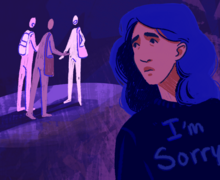3 takeaways from the March for Our Lives in Washington, D.C.
India Miraglia | Staff Writer
People said they supported students marching in the same way they supported protesters during the Women's March last year.
WASHINGTON, D.C. — Hundreds of thousands of people were packed together on Pennsylvania Avenue on Saturday morning as the Washington, D.C. March for Our Lives anti-gun violence protest began.
Officials previously said they expected 500,000 people to attend the event, which was spurred by the violent school shooting at Marjory Stoneman Douglas High School in Parkland, Florida, in mid-February.
Here are three takeaways from the start of the protest.
Street security
Security levels were high at the march on Saturday morning. There were more than 100 volunteers, all of whom were told to stay alert.
Police cars and barricades were being used to keep protesters on Pennsylvania Avenue, the site of the march. Police would not say the exact number of officials on duty. All officers were armed with at least two guns, but no semi-automatic or automatic weapons were in sight.
Stacey Callahan, an attendee at the March for our Lives who also protested during the Women’s March last year, said there is more security at this year’s march, but she was surprised that no one asked to check her bag.
Security got tighter as the morning progressed. Some people were turned away from certain entrances, telling them to enter at 7th Street.
Items such as selfie sticks, signs mounted on wooden posts, backpacks and dogs, all previously said to not be allowed, were seen at the march.
Women’s March lingers
Several rally attendees at the March for Our Lives early Saturday morning also protested at the Women’s March last year, opposing the election of President Donald Trump.
“It’s a whole different issue and equally important,” said Jane Seebold, an attendee from Baltimore. “I was very impressed with the students and their rallying cry and I wanted to get behind it, so I’m supporting them like I was supporting women.”
Margaret Ali, a school psychologist from Woodstock, New York, said there were less pink pussyhats, a symbol of the Women’s March last year, at the March for Our Lives.
Another woman attending the march, who declined to be named, said her sister knit the pussyhat she was wearing for the march because she expected more people to be wearing them.
“And just the energy of being surrounded by like-minded people is so positive, and it makes you feel a little hopeful for the future,” Ali said.
Future focus
Stickers were handed out to people who cannot yet vote with the year they will be able to vote. Families with kids flooded the march site.
“These kids have really inspired me and given me hope that things can change,” said Tommy Schoendorf, of Baltimore. “And I’m hoping that the press and attention that this receives will really inspire young and old, and that these kids will really get out and make a difference by voting and inspire the rest of us to keep up the fight.”
Ali, the school psychologist, said both she and the students at the school she works at are afraid to come to school following the shooting at Marjory Stoneman Douglas High School. She said children’s lives are worth more than corporate greed or money.
“(Kids are) catching people’s attention. There is something about the energy of kids,” said Jennifer Timinski, who attended the rally with her teenage daughter, Riley. “Kids don’t like for people to assume they can’t do something.”
Published on March 24, 2018 at 1:03 pm
Contact India: irmiragl@syr.edu





